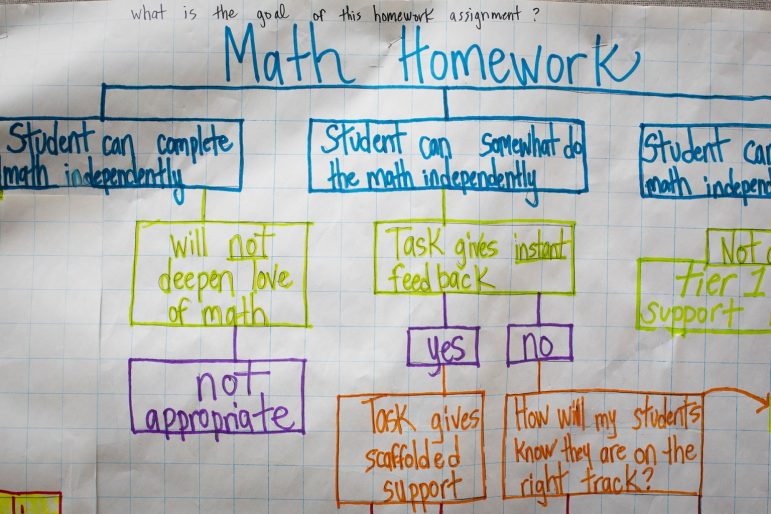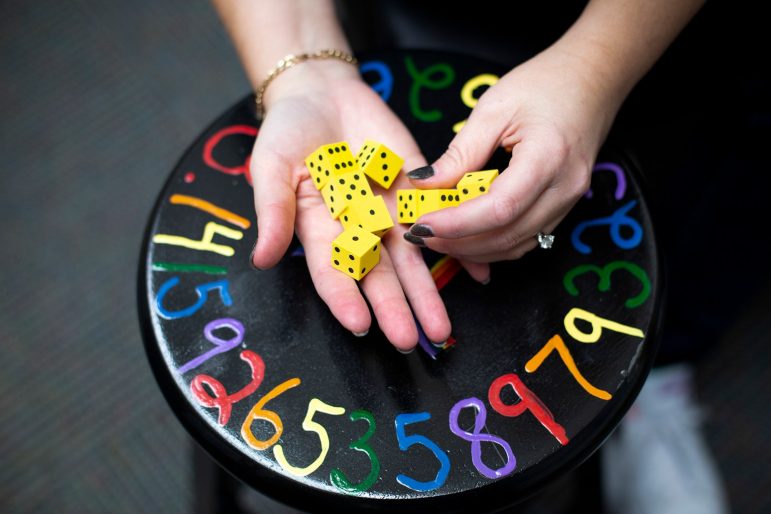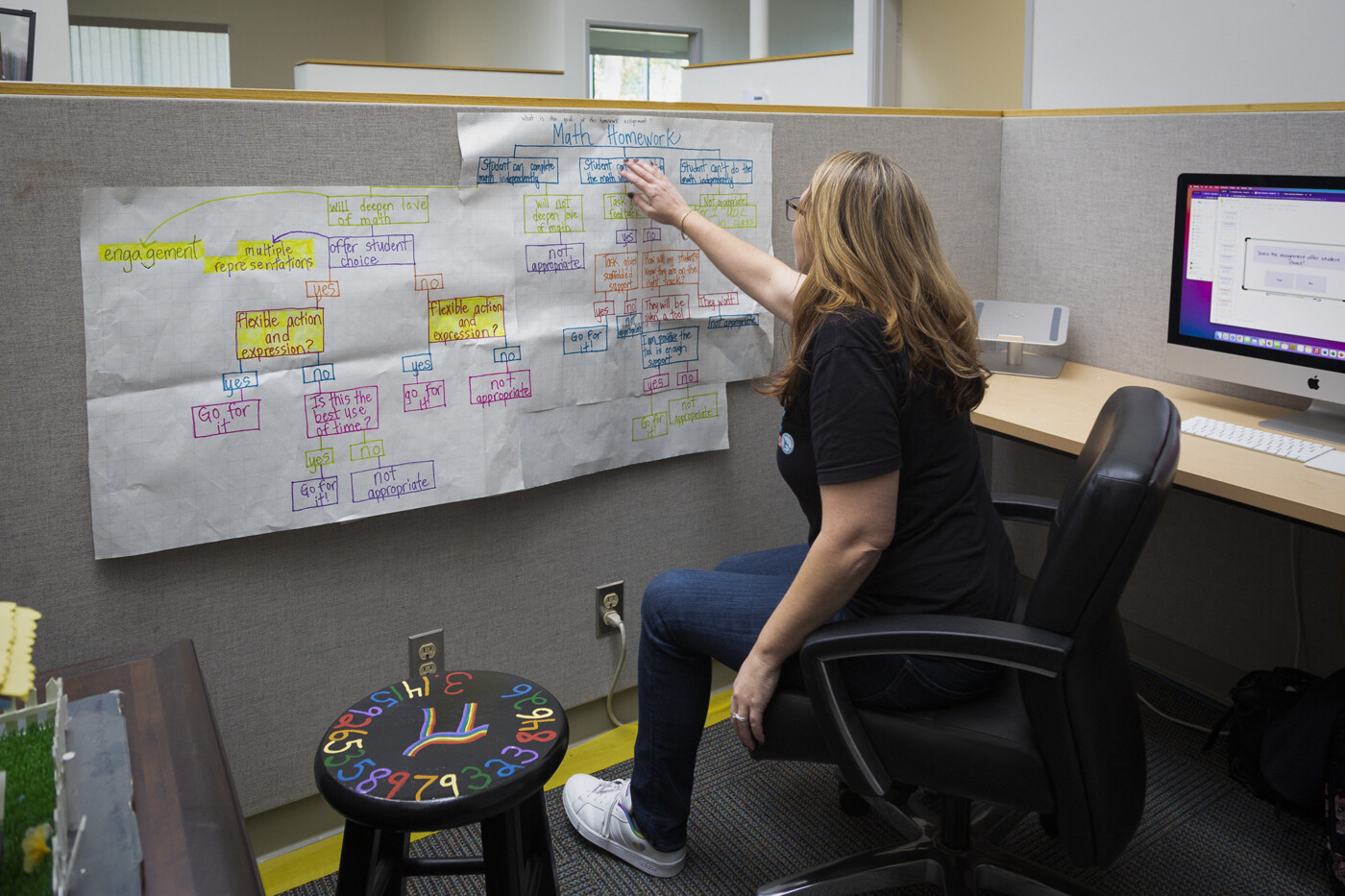When Rebecca Pariso agreed to join a team of educators tasked in late 2019 with California’s new mathematics framework, she said she expected some controversy.
But she didn’t expect her work would be in the national spotlight.
“We were transforming math education, and change is hard and scary,” said Pariso, a math teacher at Hueneme Elementary School District. “Especially if you don’t understand why that change needs to occur. But I didn’t expect it to go this far.”
Every eight years, a group of educators comes together to update the state’s math curriculum framework. This particular update has attracted extra attention, and controversy, because of perceived changes it makes to how “gifted” students progress — and because it pushes Algebra 1 back to 9th grade, de-emphasizes calculus, and applies social justice principles to math lessons.
Their intent, the framework’s designers say, is to maintain rigor while also helping remedy California’s achievement gaps for Black, Latino and low-income students, which remain some of the largest in the nation.
At the heart of the wrangling lies a broad agreement about at least one thing: The way California public schools teach math isn’t working. On national standardized tests, California ranks in the bottom quartile among all states and U.S. territories for 8th grade math scores.
Yet for all the sound and fury, the proposed framework, about 800-pages long, is little more than a set of suggestions. Its designers are revising it now and will subject it to 60 more days of public review. Once it’s approved in July, districts may adopt as much or as little of the framework as they choose — and can disregard it completely without any penalty.
“It’s not mandated that you use the framework,” said framework team member Dianne Wilson, a program specialist at Elk Grove Unified. “There’s a concern that it will be implemented unequally.”
District officials at Cupertino Union School District, for instance, sent families a letter in May saying despite the state framework, it doesn’t plan to “make shifts to our math courses in the foreseeable future.”
Pariso wanted to be a voice for her students among the 20-member team. In her 7,500-student school district in Ventura County, 42% of students are English Learners and 84% qualify for free or reduced-price lunch. She said students like hers have long been dismissed as lacking math skills due to language barriers or factors outside the classroom like housing or food insecurity. The result, she said: In a state that’s home to giant tech companies, her students are alienated from careers in science, math, engineering and technology.
“There’s a huge problem with math instruction right now,” Pariso said. “The way things are set up, it’s not giving everybody a chance to learn math at the highest levels.”
Mariah Rose, a third-year applied math major at UC Berkeley, said she didn’t have another Black classmate in any of her math classes until this semester.
“There’s one other Black student in my class right now, and that’s just crazy to me,” said Rose. “The number of Black and Brown people in math is so low.”
Rose, who is half Black and half Latino, said this is nothing new. She said she was the only Black female student in her advanced math classes during high school. And her successes in math make her an outlier in California’s public school system where Black and Latino students score lower on standardized tests.
But the question of how to close this gap has opened up another divide between math education experts and academic mathematicians.
In July, hundreds of mathematics and science professors signed an open letter calling on the state to replace the proposed framework. Academic mathematicians say their input is valuable because not only have they gone through the entire math pipeline, but they also know what elementary math builds up to.

Svetlana Jitomirskaya, a mathematics professor at UC Irvine, said the authors of the committee should have consulted more experts in the STEM fields who are more familiar with the advanced education and training students need after high school.
“The process should have definitely involved STEM faculty from top CA universities with direct knowledge of what is needed for success as STEM majors,” she emailed. “It is absurd this was not done.”
And some education specialists say the framework would hurt historically marginalized students the most by injecting too many social justice related topics that distract from the math.
“The way you get social justice in mathematics is to teach the kids math,” said Tom Loveless, a retired math education expert who worked for the Brookings Institution, a national think tank. “It’s not by dressing up mathematics in social justice.”
Jo Boaler is the framework’s primary author and a math education professor at Stanford University. She and other advocates of the framework say university professors — who work with older and more motivated students who elect to take higher level math courses — might not have the insight needed to build a K-12 curriculum, especially for historically marginalized student groups.
“We understand education, and they have no experience studying education,” Boaler said. “Mathematicians sit on high and say this is what is happening in schools.”
Ben Ford, a mathematics professor at Sonoma State University and one of the framework’s authors, said he’s also optimistic that, especially at the Cal State Universities that prioritize instruction over research, the divide between mathematicians and math educators is narrowing.
“The mathematics community cares a lot these days about broadening participation,” he said. “I think we’re getting a lot more sophisticated about how our methods contribute to exclusion.”
A key sticking point in the approval process has been the framework’s recommendation that teachers refrain from labeling students as “naturally talented” in math. This has led to accusations from parents and educators that it holds back “gifted” students.
“Holding back high achievers makes them achieve more?” said Avery Wang, a parent of a Palo Alto Unified student. “That’s exactly the same philosophy that’s being promoted in the math framework.”
Boaler said the revised draft will contain more suggestions for advancing students more quickly in math based on merit.
The framework also calls for more relatable and practical instruction, whether that be through using more inclusive pronouns or word problems related to real-world issues like housing and climate change.
To critics, that sounds perilously like dumbing down math.
“They’re changing math to make it math appreciation,” said Michael Malione, a parent in the Piedmont City Unified School District who works as a private math tutor. “A part of math is learning things that are not authentic to life.”
Malione and other parents say the framework does a disservice to historically marginalized student groups by offering them a simplified version of math that fails to prepare them for the challenges of a career in science, tech, engineering or math.
“Math is gonna be hard for students who don’t enjoy it as much,” Malione said. “But that’s the price you pay for giving them an opportunity to study STEM.”
Advocates of the proposed framework argue that critics are too fixated on protecting students who are already doing well in math. In California, these students tend to be white, East Asian or come from more affluent households.
“The people who advocate for traditional methods see the goal of math instruction as finding the brilliant ones and helping the other ones just get through life,” Ford said. “We’re thinking about the people we miss. That’s the motivation for a lot of us working on the framework.”
Rose, the UC Berkeley math major, said she has mixed feelings. She agrees with the framework’s recommendation to delay more advanced math classes and avoid labeling students based on their math abilities at younger ages. But she isn’t sure if she would be where she is if she hadn’t been accelerated into a higher-level math class in 6th grade.
“It was a game changer,” she said. “I don’t know if I would’ve pursued math if I hadn’t advanced so early.”
The framework would not forbid districts from accelerating students in middle school. It does, however, recommend that middle-school students all take the same sequence of “integrated” math classes that blend concepts from arithmetic, algebra and other subjects with the goal of cultivating a foundation and comfort level with numbers.
On top of that, the framework recommends that schools postpone offering students Algebra 1 until 9th grade or later, when it says more students are likely to be able to master the material.
“When kids struggle, they immediately say ‘I don’t have a math brain,’” Boaler said. “That changes how the brain operates.”
Delaying Algebra 1 until 9th grade, however, would require other high school math classes like Geometry, Algebra 2 and Pre-Calculus to be compressed so that students can reach AP Calculus by 12th grade. At San Francisco Unified, which implemented this pathway in 2014, students took a one-year class that combined Algebra 2 and Pre-calculus.
Jitomirskaya said that waiting until high school for Algebra 1 would result in accelerated pre-calculus courses that would be too difficult for most students.
Norm Matloff, a computer science professor at UC Davis and a critic of the framework, said compressed mathematics classes are “dangerous” because they inevitably leave out parts of the curriculum. He said taking classes like Geometry and Algebra in the same year as two separate, year-long classes is a better idea.
For Boaler and her co-authors, integrating traditionally separate math classes goes hand-in-hand with open-ended inquiry. For example, instead of assigning repetitive problem sets, teachers would use collaborative projects such as calculating the living wage in the students’ communities. Open-ended assignments like this don’t necessarily have a single right answer in the back of the book.
“Math can be very boring for kids,” Boaler said. “It’s just about doing these short questions that don’t have any meaning.”
Some education experts and math professors say the framework’s emphasis on open-ended assignments just leads to confusion, especially for struggling and historically marginalized students.
Loveless said teaching through open-ended problems can make students feel lost. He suggests teachers use lecture-style lessons to introduce students to concepts.
“It’s a long standing philosophical dispute,” he said. “Math education departments tend to be very progressive in their points of view.”
The framework also creates a new high school data science course as an alternative to calculus. The authors say this course will result in a more diverse student body pursuing careers in science, technology, engineering or mathematics. But some experts say calculus is vital to prepare students for a STEM career.
“If you want a job in data science that isn’t replaceable by a computer in the next couple of years, you need to take calculus,” said Jitomirskaya, the UC Irvine math professor. “They want a data science course that is completely dumbed down.”
State data indicate that not only do relatively few students take calculus in high school, but the number of students enrolling in the most advanced calculus classes — already just 3.7% in the school year beginning in 2014 — dropped in four years to a mere 3.4%.
The framework’s authors counter that taking calculus in high school shouldn’t be necessary to enter a STEM field in college and beyond, especially because calculus can be a barrier to entry for Black and Latino students.
“Derivatives and integrals aren’t important to get into college. The college credit and the AP exam are more important,” Ford said. “Many of us at the college level would prefer students to come to us more ready to take Calculus 1.”
In fact, the University of California and Cal State systems have taken steps to de-emphasize calculus as an admissions requirement.
Rose, the UC Berkeley student, said she didn’t come to appreciate the beauty of calculus until she reached college. In fact, she said her classmates who came to college without having taken AP Calculus sometimes scored higher than she did in their university-level calculus courses.
“Calculus has this whole reputation of getting you into college, but calculus is so much more than that,” Rose said.
Other critics lambaste the new framework as “woke math” that “de-mathematizes math” with social justice lessons and left-wing ideology.
An open letter signed by over a thousand STEM experts condemned the framework for suggesting that teachers highlight the “contributions that historically marginalized people have made to mathematics,” “take a justice-oriented perspective at any grade level,” and use inclusive gender pronouns.
A Wall Street Journal editorial that helped spark national interest in California’s math curriculum and conservative publications like the National Review have objected to the framework’s occasional citation of “A Pathway to Equitable Math Instruction,” a manual that aims to show math teachers how they can use their class to combat white supremacy. The manual asserts that current math pedagogy in the U.S. reinforces white supremacy in a variety of ways; its critics say numbers are numbers, so how can there be racism in math?
The authors removed references to the manual shortly thereafter.

Matloff, the UC Davis professor, said he has no problem with inclusive language, but that “wokism” shouldn’t come at the cost of the math. “I have a problem when people make an obsession out of race,” he said. “They lose sight of the issue, which is to teach kids math.”
Critics have also attacked recommended assignments that try to apply math concepts to social science topics.
But Brian Lindamann, one of the authors of the framework, said divisions between the two fields are often “artificial.”
“For example, something like understanding how cost-of-living works — that’s both mathematics and social justice,” he said. “The intersectionalities of many of these disciplines are the very things that propel society as a whole. Why not have an economics teacher and a math teacher teach a class together?”
And while some critics roll their eyes at the idea of, for instance, using “they” and “them” as a non-gendered singular pronoun, educators like Pariso say insensitive language can be a significant obstacle to learning.
She noted that an earlier draft of the framework included sample lessons on calculating a school cafeteria’s food waste — but that many of her students would have found the entire exercise alienating because they lack food security at home.
The framework committee met several times over eight months, in-person at first and then virtually once the COVID-19 pandemic gripped California. Pariso describes the meetings as an “intense” collaboration between math teachers, school district administrators and math education experts.
She and the committee gave their final recommendations for the state’s math framework to a writing team during a series of meetings that ended in December 2020. These authors, five professors from across the state, wrote an 800-page draft that generated both praise and criticism.
After absorbing blowback in hours of public testimony, the California State Board of Education delayed the approval process by two months.
Whatever impact a new framework has, California public schools still face systemic challenges.
Aris Biegler, a Los Angeles math teacher who helped design the framework, said smaller classes are key: “If a kid isn’t comfortable multiplying six times four, I can sort of reinforce them without shaming them.”
But amid an ongoing teacher shortage, teaching is less appealing for those graduating college with STEM degrees.
“I have students who are very passionate about teaching and would very much consider teaching high school,” Jitomirskaya said. “But they would prefer the higher paying STEM jobs.”
Even so — and acknowledging that not all districts will fully implement all the new framework’s recommendations — Pariso said it’s a step in the right direction.
“I used to value and make a big deal about students who got 100%,” she said. “But after reflecting and learning about Jo Boaler’s tools, I realized I needed to take time to celebrate the students who are progressing. I don’t really talk about the one-hundred-percenters any more. I say ‘Wow, look how far you’ve come.’”

Remedying the achievement gap by depriving students of real math education systematically all over the state seems more like a way to hide the failing of public education than an effort to bolster the weakest students. If we lower the bar and stop testing then suddenly everyone succeeds? This is a very bad idea that limits students and makes teachers less accountable for demonstrable educational success.